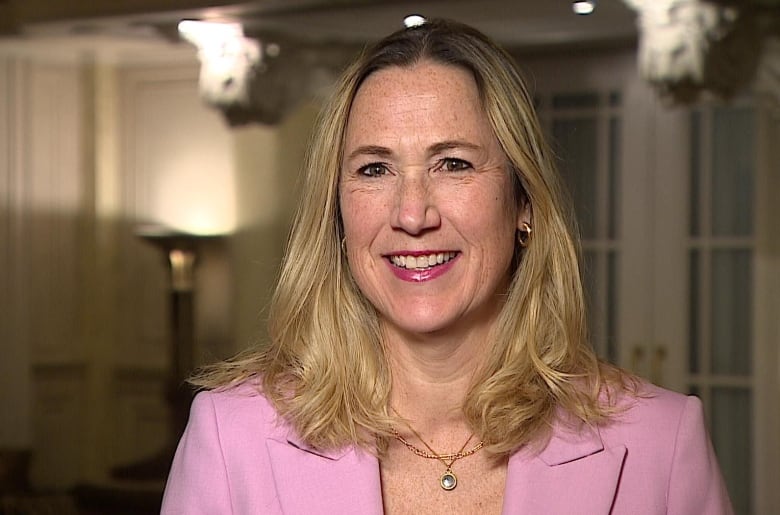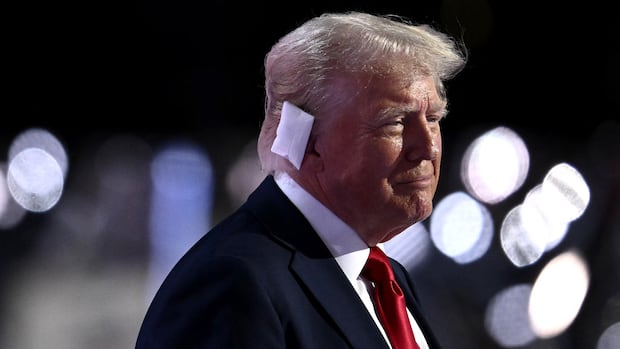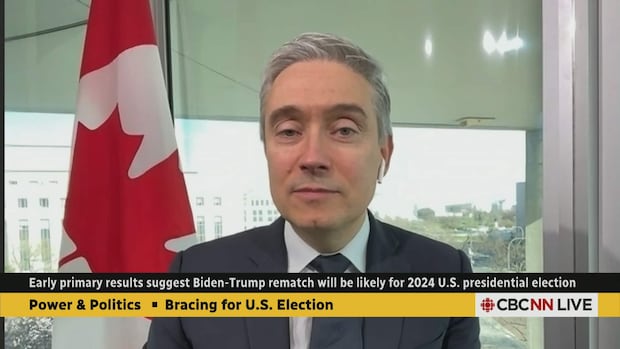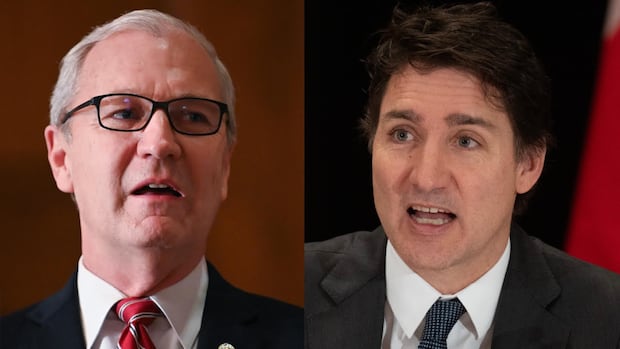
Polls suggest former president Donald Trump is in a strong position to win back the presidency this November — a development that could have wide-ranging implications for Canada, given how tumultuous his first term was for this country.
Trump leads a united party despite sometimes intense opposition and criticism of his election denial and role in the January 6 insurrection attempt.
Elected officials and card-carrying Republicans — even former anti-Trumpers — have rallied around him at this week’s convention after the failed assassination attempt. The former president is leading in every electoral battleground and other states previously thought to be safe for the Democrats.
President Joe Biden is in a weak position as more and more Democrats call on him to step aside and give someone else the chance to take on Trump.
The prospect of a second Trump presidency brings the possible consequences for Canada into sharper focus.
Prime Minister Justin Trudeau has tapped Industry Minister Francois-Philippe Champagne to be his point man on bilateral irritants.
Champagne has been jetting around the U.S. — he’s been to New York, Michigan, Ohio, Georgia, Washington D.C., New Jersey and Nebraska in recent months — to lobby officials to protect bilateral trade from possible disruptions, or worse.
“Throughout these visits, he has actively engaged with key influencers, including mayors, governors, labour leaders and chambers of commerce, who recognize the increasing interconnectedness of our economies,” a spokesperson for the minister said in a statement.
Laura Dawson is a Canada-U.S. relations expert and the executive director of the Future Borders Coalition.
She said that while there may be some opportunities for Canada with a second Trump presidency — his pro-fossil fuel agenda could be a boost for the oilpatch — there are many more challenges to consider with such an erratic leader in the White House.
“I think it’s quite likely we will have a second Trump presidency. It is a very real possibility unless something really unforeseen happens. He’s not just the Teflon candidate, he’s the man of steel at this point,” she told CBC News.
A possible second Trump presidency could lead to a revival of protectionism and a combative relationship between Canada and the U.S., she said.
Trump’s former trade representative Robert Lighthizer has said Canada-U.S. relations were at their lowest point since the War of 1812 during the NAFTA negotiations of 2017-18.
Dawson said a second four-year term could be just as fraught.
“A Trump victory gives Canadians pause, it gives Canadians reason for concern. We have a pretty good idea of where the Trump team will be going on issues affecting Canada and none of them are very good,” she said.
Trump’s platform is released
The Republican Party’s recently released platform is shorter — it’s just 16 pages — and less detailed than previous platforms.
Written in a Trumpian prose style, the platform is reminiscent of his social media posts — it’s heavy on populist rhetoric and sloganeering and short on details.
But it suggests a second Trump presidency would be narrowly focused on illegal immigration (he wants to “carry out the largest deportation operation in American history”) and imposing trade sanctions.
It puts allies like Canada on notice that they will have to spend more on defence — or risk losing U.S. military support.
Donald Trump told the crowd at the Republican National Convention what happened during an assassination attempt at a campaign rally in Butler, Pa., on Saturday. The former president said it’s the only time he’ll tell the story because it’s too painful for him to recount.
It also promises to “drill, baby, drill” — to flood the market with cheap energy products to try to bring down inflation and gas prices.
All of these priorities could touch Canada in meaningful ways.
“We are a Nation in SERIOUS DECLINE. Our future, our identity, and our very way of life are under threat like never before. Today we must once again call upon the same American Spirit that led us to prevail through every challenge of the past if we are going to lead our Nation to a brighter future,” the platform reads.
Tariff threat looms over Canada-U.S. trading relationship
The issue top of mind for Canadian political, business and labour leaders is the bilateral trading relationship.
The federal Liberal government successfully renegotiated NAFTA with Trump and Mexico in 2018 after a sometimes heated battle with Lighthizer and anti-free traders in Trump’s circle like Peter Navarro.
The new NAFTA left the trading relationship intact and did relatively little damage.
In fact, U.S. exports to Canada and Canadian imports were a lot higher last year than they were in 2015, according to U.S. Census data.
But Trump’s platform is again blasting out messages about “unfair Trade Deals” and “blind faith in the siren song of globalism.”
“For decades, our politicians sold our jobs and livelihoods to the highest bidders overseas,” the platform reads.
One immediate priority for Canadian officials will be pushing back on Trump’s proposal to impose tariffs as high as 10 per cent on all U.S. trading partners as part of a bid to spur companies to make more products in America, Dawson said.
Despite looming threats to Canada-U.S. trade relations from presidential candidate Donald Trump, ‘Team Canada’ is confident American industry leaders know that Canada is ‘essential’ to economic growth in North America, says Minister of Innovation, Science and Industry François-Philippe Champagne.
“I don’t see a way to shield the USCMA from that 10 per cent universal tariff in the short term. Canada is going to have to contend with this and it’s going to create investor insecurity, instability,” Dawson said, referring to the U.S.-Canada-Mexico Trade Agreement.
“The second Trump administration will be doing everything it can to focus investment, jobs and attention on the U.S. to the exclusion of neighbours and allies.”
Ohio Sen. J.D. Vance, Trump’s pick for vice-president, telegraphed what’s to come in his keynote address to the Republican convention in Milwaukee on Thursday.
Vance said Biden, as a past senator who supported NAFTA, “sent countless good jobs to Mexico” and gave China a “sweetheart trade deal that destroyed even more good, American middle-class jobs.”
“We’re done sacrificing supply chains to unlimited global trade, and we’re going to stamp more and more products with that beautiful label, ‘Made in the U.S.A.,'” Vance said.
Kirsten Hillman, Canada’s ambassador to the U.S., said Canada will push back against protectionism that could be damaging for interests on both sides of the border.
Speaking on the sidelines of the Republican convention, where Trump was officially nominated, Hillman said Canada is already in talks with the former president’s inner circle about some sort of exemption.

“We’re talking to Trump’s advisers on this,” Hillman said during a panel hosted by Politico and CNN.
“We are really urging them to consider what the implications would be.”
Trump’s representatives are being non-committal about giving Canada a break from the proposed tariffs, CBC News has reported. Canada is considering some sort of trade retaliation if there’s no exemption.
Dawson said one solution to these trade woes is a revival of the NAFTA-era “Team Canada” approach that helped get the revised trade deal over the finish line, with federal, provincial, local and business and labour leaders meeting with Americans to protect bilateral trade.
Protecting the new NAFTA, which will come up for a review in 2026, is also a priority for Canadian officials. After all, more than 78 per cent of Canada’s exports went to the U.S. last year.
Republicans critical of Canada’s defence spending
While trade irritants are an almost constant feature of the Canada-U.S. relationship, Canada’s position as a relative laggard on military spending has emerged as a new area of dispute.
Republicans have trashed Canada’s military spending in recent weeks, saying Ottawa needs to finally fulfil its longstanding NATO commitment to spend two per cent of national GDP on defence.
Republican House Speaker Mike Johnson, a staunch Trump ally, has said Canada has been riding U.S. “coattails” for too long.
“They have the safety and security of being on our border and not having to worry about that. I think that’s shameful,” he said.
A bipartisan group of U.S. senators has written a letter to Prime Minister Justin Trudeau, urging him to meet the NATO spending target Canada first agreed to in 2014. Kevin Cramer, a U.S. senator who co-wrote the letter, says Canada has to ‘step up a little bit’ to help secure freedom.
Mitch McConnell, the Republican leader in the Senate, said in a media statement “it’s time for our northern ally to invest seriously in the hard power required to help preserve prosperity and security across NATO.”
Speaking Thursday, Vance said a Trump administration will ensure there’s “no more free rides for nations that betray the generosity of the American taxpayer.”
That could foreshadow what’s to come if Trump actually wins.
At a rally in South Carolina earlier this year, Trump said the U.S. would not protect allies who fail to meet the two per cent target.
“In fact, I would encourage them to do whatever the hell they want,” he said of unnamed military adversaries. “You gotta pay. You gotta pay your bills.”
Canada has pushed back against the claim that it’s a freeloader, saying the country is among the top five NATO nations in terms of increases to military spending since 2015.
And last week, Trudeau said Canada would hit the two per cent target by 2032 but offered no plan to get there.
David Perry, the president of the Canadian Global Affairs Institute, said the Americans are fixated on Canadian military spending right now.
Now that Canada has made the commitment to get to two per cent in eight years’ time, it will have to produce a credible plan to get there to counter American criticism, Perry said.
“For our allies, this metric matters. I was down in D.C., the spending pledge, two per cent, came up over and over again,” Perry told CBC News of his talks on the sidelines of the recent NATO meeting.


